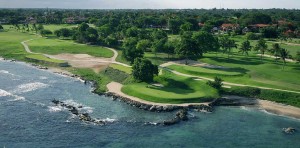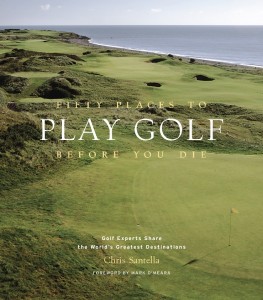
The fifth hole at Teeth of the Dog, one of the great par 3's that Pete Dye sited along the Dominican coastline.
When Pete Dye first visited the site near La Romana, Dominican Republic, that would one day become Teeth of the Dog in 1968, it was hard to imagine much of anything growing there, let alone the Caribbean’s most celebrated golf course. “The land was pretty much useless, at least for human purposes” he recalled. “It was too dry for growing sugarcane and there was too little vegetation to graze cattle. No one much cared about it.” After flying over the land by helicopter and drifting along the coastline in a skiff, Dye decided that he needed a closer look. “I went out and walked the land and suddenly noticed that there were three distinct areas that were concaved, all along the same stretch of shoreline. I wanted to measure the areas. Back in town, I couldn’t find a tape measure, but was able to locate a yardstick. I measured off one hundred feet of rope and went back to the site. The first concave was three hundred eighty years, the second two hundred, and the third four hundred fifty yards. Here they were, right in succession. On the other nine, the sixth and eighth were concave too. There was a little area in the middle that went the other way. I manufactured the seventh hole. The others were all right there. You usually don’t find such things along the edge of the ocean. It was like the man upstairs had laid out those holes.”
Casa de Campo, the lavish resort that hosts Teeth of the Dog and two other fine Dye creations (the Links, designed with Pete’s wife, Alice, and Dye Fore), has emerged as one of the Caribbean’s great escapes. The brainchild of a sugar baron named Alvaro Carta, the 7,000-acre grounds of Casa de Campo include three polo fields, a large marina, fifteen swimming pools, a state-of-the-art shooting center, a tennis center, a host of first-class restaurants, and a range of accommodations from comfortable to decadent. The scene is completed by the presence on a nearby hillside of Altos de Chavón, a replica sixteenth-century Mediterranean village. While vacationers from Europe, South America, and the United States come for the vacation amenities, which are amplified by the friendly Dominican staffers, golfers—as the resort’s promotional literature states¾come to “take a bite out of the dog.” Whether they bite or are bitten, players who have gone around once are generally quite eager to take on Teeth of the Dog again . . . and again.
The “teeth” of Teeth of the Dog refer to a local nickname for the island’s jagged-edged coral reefs; while the course’s owner wanted to name the track Cajuiles after the cashew trees that grew in the mountains, Dye lobbied for Teeth of the Dog and eventually won. The course was built without the use of heavy machinery, and the detailing is evident. After four relatively tranquil holes that meander downhill, you finally reach the sea. Four fabulous water-side holes follow, including two of golf’s great oceanside par 3s: the 157-yard fifth and the 224-yard seventh. The wind is often blowing from the water or toward it. When the wind is coming off the water, one needs nerve to start one’s shot over the Caribbean—and faith that the breeze will bring it back to the peninsular greens. “Down on the fifth and the seventh holes, you’re so close to the water that you can feel the spray,” Pete Dye said. “You can look into that clear Caribbean Sea and see the fish¾you’re only four feet above it at high tide. You feel like you’re practically in the water.” Local divers who collect recently lost balls from the shallows along holes five through eight find many willing customers among players heading for the back nine.
There are many memorable holes at Teeth of the Dog, providing stimulation for all the senses. In a recent story on TravelGolf.com, writer Judd Klinger described how in the eighties, players teeing off on the fifteenth might have had the chance to glimpse naked supermodels; the villa there was once the residence of Oscar de la Renta, and the designer’s legion of models would sometimes sunbathe au natural in sight of the tee box. Many feel that the 194-yard par 3 sixteenth is the course’s most spectacular hole. It is here that the coral “teeth” are most prominent, resting just to the right of the green. Lining up to play your tee shot into the well-bunkered green as the foam bubbles up from the waves below borders on the sublime.
In coming years, Teeth of the Dog may have competition for its perennial rank as the Caribbean’s finest course. This will come from the newest Dye course at Casa de Campo, Dye Fore. Set well above the coast along the deep bluffs of the Chavron River, Dye Fore offers staggering views of both the ocean and the mountains, which in the Dominican Republic reach heights of 11,000 feet. “We had all the land in the world to work with, so we routed the course right along the top of the river. You can see the river entering the Caribbean Sea to the south, and look to the north to mountains, and you get this vista on almost every hole. Some of the greens are hanging out on the bluff, so you might find yourself looking down seventy meters to the river below.”
While Dye’s signature pothole bunkers and ample opportunities to dunk a ball make Teeth of the Dog and Dye Fore a constant challenge, the course remains quite playable; perhaps that’s part of its long-standing popularity. That, and the views. “Ambience is such an important aspect of any golf course’s success,” Pete Dye ventured. “If you want to put a course on the map, build a course next to the ocean, in the mountains, or arrange it so Ben Hogan or Arnold Palmer can win the first tourney there. It’s so important to have an outside ambience.”
Pete Dye is considered one of the most influential golf course architects of the past fifty years. Each of his designs is distinct from the rest, yet each bears the signature Dye style and challenge. Dye’s hands-on approach and organic style are superbly influenced by the traditions of the game. In fact, it was in 1963 that Dye’s style congealed on a visit to Scotland. It was there that he discovered railroad ties, tiny pot bunkers, and many other course elements that he has successfully incorporated over the years. Most of these features can be found on many of his internationally celebrated courses, including the Stadium Course at the Tournament Players Club at Sawgrass, the PGA West Course, the Ocean Course at Kiawah Island, and Whistling Straits in Kohler,Wisconsin. His work also includes a collaboration with Jack Nicklaus on the Harbour Town Golf Links in Hilton Head, South Carolina.
Getting There: Casa de Campo is located near the town of La Romana, roughly thirty-five miles from the Dominican capital of Santo Domingo, which is served by most major airlines.
Course Information: The par 72 Teeth of the Dog measures 6,888 yards from the back tees and has a slope rating of 140. Green fees for hotel guests during high season are $170; during the spring and summer, fees are $95. In addition to the resort’s fine offerings, the private La Romana Country Club is sometimes accessible to Casa de Campo guests. Call 800-877-3643 or visit www.casadecampo.com.do for more information.
Accommodations: Amidst its 7,000 acres, Casa de Campo offers a range of accommodations, from standard guest rooms to elegant villas. Guests have access to a golf cart to convey them around the vast property. Between Casa de Campo and the faux-Mediterranean town of Altos de Chavón, you’ll find a host of fine restaurants, which include the Tropicana, Casa del Rio, and La Piazzeta.

